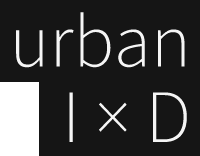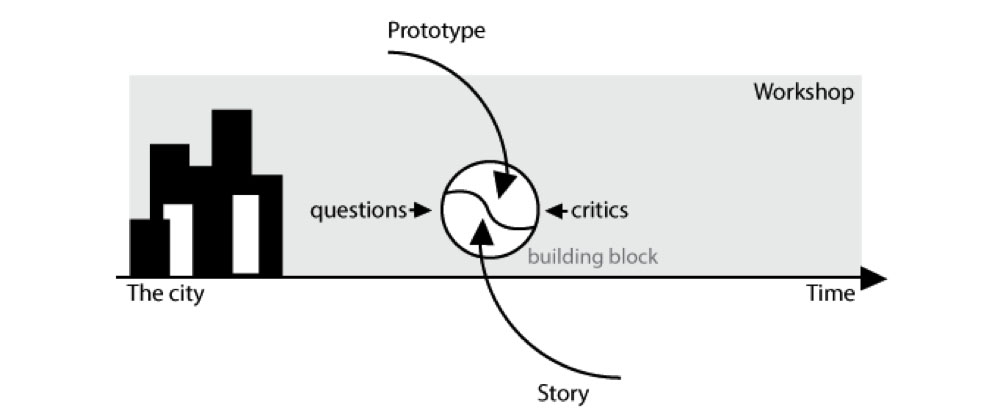by Sjors Timmer, UrbanIxD Summer School attendee, freelance interaction designer at Notura.com
If the 19th century was about discovery and the 20th century about obtaining efficiency, then the 21st century will be about living with complexity. Complex adaptive systems are so big and interconnected that any interference with their workings causes unpredictable side effects. In these systems (such as a city) you are almost always dealing with situations that need to be addressed and rarely with problems that can be solved. For this new way of working, where every step forwards needs to be taken with caution, we need a new method, a new language and a new approach. The finding and fine-tuning of this way of working with the world was what for me the UrbanIxD summer school was about.
The challenges for cities are many: what should they expect from technology? How will the networked computer change the way we work? What are the possibilities and limits of urban change in a democratic framework? What about our environment and resources, and how can we include other people, legislations and resources in this challenge?
Challenge the major consensus narrative
In the 18th century the idea that the world is knowable, and therefore all its problems solvable, took root. And ever since it has manifested itself in many different big narratives. In the last decades the idea of a world where all problems can be solved has become a powerful tool in the hands of technology companies and has been rebranded several times from information to knowledge society and from cyberspace to beyond. In the summer school we dealt with its latest incarnation the idea of Big Data and Smart Cities, a narrative once more dreamed up to get all humanity facing the same way. Hidden in the midst of it, is the assumption that obtaining information and achieving efficiency are goals superior to any other. As Ghandi once said, there’s more to life than increasing its speed, and there is certainly more to cities than increasing the efficiency of garbage, traffic or electricity systems (no matter how lofty these goals are). One of the summer school’s goals was therefore also to challenge the, as Bruce Sterling calls it, ‘major consensus narrative’.
Not only does the Smart City as a solution rely on efficiency obtained through technology, the benefits will also –as is usually the case with big narratives– only reveal themselves in the nearby, but never reachable future. Like El Dorado, the mythical city of gold, the future always sparkles and twinkles a little bit over the horizon, luring in travellers from afar, roaming nomads who are willing to bring the greatest sacrifices in anticipation of infinite returns.
Although certainly less exciting –and harder to sell– a healthier approach to future-making would be to see it as a mundane side effect of making life a little better here and now. Future-making as a ceaseless process of prototyping and story telling, whereby it emerges not as the end product but as the scraps of ideas swept in the corner after cleaning the atelier for another day of workshops. The future should not focus on what technology can do for us, but help us explore and expand what it means to be human (without destroying ourselves and our environment in the process). The school provided some hints of a process to accomplish this.
In a world where more than 50% of all humans live in cities –and even more than 70% in Europe- the city is the predominant scale of civilisation to work with. Big enough to host a broad spectrum of human life, yet still small enough to be travelled through in one day. Where the idea of a nation is mostly the result of careful campaigns and history books, the city is much more alive, an ever changing mix of prototypes and stories. How cities function as stories became very clear to me in Split, no longer surrounded by the familiar of smoky London, some of my previous ideas of what made a city of the future –locals working away on laptops in coffee shops– suddenly felt of another space-time, whilst new ones –locals working in restaurants, as guides or as apartment hosts– became a different way of seeing future cities. In a further continuing globalisation it is important to realise the very strong influence place has on what can be thought and made. In ways not earlier realised by me, the city is as much constructed in the mind of the citizen as the citizen’s mind by the city.
The atelier of the neighbourhood
If we zoom in further we arrive at a place that is local –or more likely these days, a set of places that together form someone’s local environment. These places the size of a street or block are where the workshops of continuous future-making take place. The atelier of the neighbourhood provides the best scale for on-going workshops where prototypes and stories are created, enacted and remade. It allows the most democratic way of future-making, with the greatest amount of options and dialogues.
One great talk on this topic was by architectural collective 9.81 whose practice focuses on people, events and legislations instead of construction. In a few abandoned sites left by the disappearance of both the communist state and heavy industry, they work relentlessly to breath new life into old spaces. As Dinko Peračić stated, “in general in Europe we don’t have to build much more”, and therefore the role of the architect has changed from the creator of buildings to the initiator of use. This, however, comes with a new set of questions: how do you bring life into abandoned places? How do you convince local and higher government to adapt the laws to make new things possible? How do you find new models of finance? And how do you convince the local public that reuse and not demolition is the right way forward? For example, they showed an abandoned factory, where they started out with nightly architecture seminars around a projector and some cardboard chairs, and eventually developed it into a great local hub.
Another case is the building the summer school took place in. Originally conceived as a theatre, it was never finished and for the last 35 years has been waiting for its legal fate. In the meantime, however, it has been taken over (supported although not legalised by the city of Split) and now hosts a variety of uses such as a supermarket in the basement, a climbing wall, a youth club, a nightclub, a health centre, a dance club, a theatre, a gallery and an atelier space big enough to host our summer school of 60 people for 10 days. This building offers an amazing example of how with the help of smart citizens and light technology, old places can become new hubs of global local communities. Places where, while no problems are solved definitively, issues are addressed relentlessly, and where the mundane future is produced iteration after iteration in a slow but ever-evolving process.
These hands-on approaches run very much counter to the idea of the big narrative, big budgets and big construction sites, and are much more in line with an alternative way. This way is made up of a multiplicity of stories and prototypes: a set of building blocks, each one compact enough to stay together, yet flexible enough to be infinitely remixed, recombined and reused. To build the future we need more building blocks and less big ideas.
The continuous workshop
To make the continuous workshop a success we have to mix four key ingredients: the question, the critic, the story, and the prototype.
The continuous workshop of future-making uses questions and critics to create building blocks of prototypes and stories that can be remixed indefinitely
Questions
Questions are the driving force of any endeavour. Unlike answers, they get better with age; they gain both breadth and depth and become ever richer and layered as time goes on. A good question is inexhaustible and allows new ideas to be continuously generated without ever coming to a stop. It enables us to explore and expand what it means to be human.
The critic
The second ingredient is the critic, a role that everyone should take on. There are many forms that critical thinking can take: we can be facilitators, builders and writers, but always we function in our role of challenging assumptions. In the summer school we found that groups of 3 or 4 people formed the best teams; for smaller groups the time constraints became a challenge, and for larger groups a lot of time was lost in discussion.
So what should all these critics in workshops question? And what form should their critique take? In the school this was done through the production of design fictions and critical design objects, or stories and prototypes. They are the strongest building blocks that we can use to remake and re-imagine the world we live in.
Prototypes
In this world, prototypes become stories made tangible, and stories turn into prototypes made fluid. Everything, no matter how big or small, should be seen as a prototype, to recognise that its current use and configuration is potentially temporary and unfinished. Everything is always on the way to becoming something else, and we have the power to shape what this will be.
Stories
Stories capture questions and answers in a way that allows us to imagine and bring to life possible worlds. The school was the place where we could start to fill the world with human-centred stories of hybrid cities, little data and smarter citizens. In our project we investigated a space beyond utopia/dystopia and explored mundane futures where even the latest technology is full of usability problems and people are –just like today- struggling actors in an ever-increasing technological world.
To make it possible for the questions, critics, stories and prototypes to work together, it is good to remember that all our efforts are forever incomplete and that we therefore should actively explore, create and reveal seams, cracks and in-between spaces: the fringes that allow us to forever multiply our questions, our options and our dialogues.
The UrbanIxD summer school was an amazing event, a week where through workshops and critical questions, guided by prototypes, stories and wise old atelier leaders the future slowly came to light. A place where we laughed, cried, and stretched our minds beyond imagination.
This post appeared earlier on Notura.com


